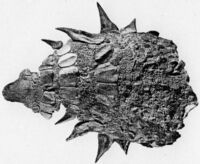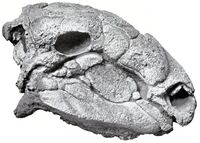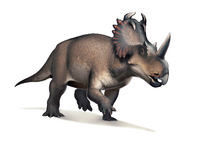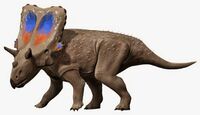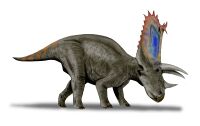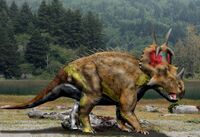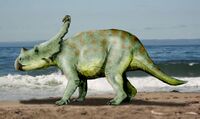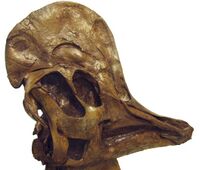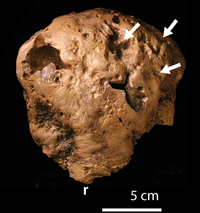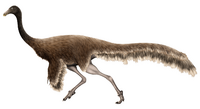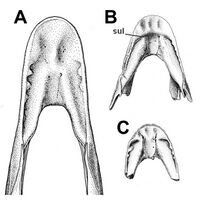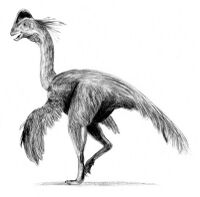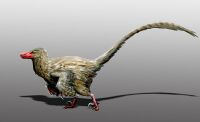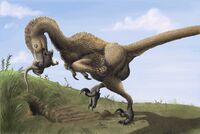Earth:Dinosaur Park Formation
| Dinosaur Park Formation Stratigraphic range: Late Cretaceous, Campanian, 76.5–74.4 Ma | |
|---|---|
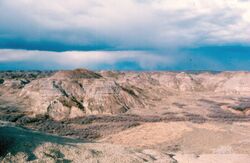 Dinosaur Park Formation exposed along the Red Deer River in Dinosaur Provincial Park, southeastern Alberta, Canada. | |
| Type | Geological formation |
| Unit of | Belly River Group |
| Underlies | Bearpaw Formation |
| Overlies | Oldman Formation |
| Lithology | |
| Primary | Sandstone (lower) Mudstone and siltstone (upper) |
| Other | Bentonite and coal |
| Location | |
| Coordinates | [ ⚑ ] : 49°12′N 110°24′W / 49.2°N 110.4°W |
| Paleocoordinates | [ ⚑ ] 56°24′N 75°48′W / 56.4°N 75.8°W |
| Region | |
| Country | |
| Extent | Western Canadian Sedimentary Basin |
| Type section | |
| Named for | Dinosaur Provincial Park |
| Named by | Eberth, D.A. and Hamblin, A.P.[1][2] |
| Year defined | 1993 |
| Lua error in Module:Location_map/multi at line 27: Unable to find the specified location map definition: "Module:Location map/data/Alberta" does not exist. | |
The Dinosaur Park Formation is the uppermost member of the Belly River Group (also known as the Judith River Group), a major geologic unit in southern Alberta. It was deposited during the Campanian stage of the Late Cretaceous, between about 76.5 and 74.4 million years ago.[3] It was deposited in alluvial and coastal plain environments, and it is bounded by the nonmarine Oldman Formation below it and the marine Bearpaw Formation above it.[4]
The Dinosaur Park Formation contains dense concentrations of dinosaur skeletons, both articulated and disarticulated, which are often found with preserved remains of soft tissues. Remains of other animals such as fish, turtles, and crocodilians, as well as plant remains, are also abundant.[5] The formation has been named after Dinosaur Provincial Park, a UNESCO World Heritage Site where the formation is well exposed in the badlands that flank the Red Deer River.[2]
Geological setting
The Dinosaur Park Formation is composed of sediments that were derived from the erosion of the mountains to the west. It was deposited on an alluvial to coastal plain by river systems that flowed eastward and southeastward to the Bearpaw Sea, a large inland sea that was part of the Western Interior Seaway. That sea gradually inundated the adjacent coastal plain, depositing the marine shales of the Bearpaw Formation on top of the Dinosaur Park Formation.[4]
The Dinosaur Park Formation is about 70 metres (230 ft) thick at Dinosaur Park. The lower portion of the formation was laid down in fluvial channel environments and consists primarily of fine- to medium-grained, crossbedded sandstones. The upper portion, which was deposited in overbank and floodplain environments, consists primarily of massive to laminated, organic-rich mudstones with abundant root traces, and thin beds of bentonite. The Lethbridge Coal Zone, which consists of several seams of low-rank coal interbedded with mudstones and siltstones, marks the top of the formation.[4]
The sediments of the Dinosaur Park Formation are similar to those of the underlying Oldman Formation and they were originally included in that formation. The two formations are separated by a regional disconformity, however, and are distinguished by petrographic and sedimentologic differences. In addition, articulated skeletal remains and bonebeds are rare in the Oldman Formation but abundant in the Dinosaur Park Formation.[2][4]
Biostratigraphy
The Dinosaur Park Formation can be divided into at least two distinct faunas. The lower part of the formation is characterized by the abundance of Corythosaurus and Centrosaurus. This group of species is replaced higher in the formation by a different ornithischian fauna characterized by the presence of Lambeosaurus and Styracosaurus.[6] The appearance of several new, rare species of ornithischian at the very top of the formation may indicate that a third distinct fauna had replaced the second during the transition into younger, non-Dinosaur Park sediments, at the same time an inland sea transgresses onto land, but there are fewer remains here. An unnamed pachyrhinosaur, Vagaceratops irvinensis, and Lambeosaurus magnicristatus may be more common in this third fauna.[7][8]
The timeline below follows a synthesis presented by Fowler (2017)[9] with additional information from Arbour et al. 2009,[10] Evans et al. 2009, and Penkalski, 2013.[11] Megaherbivore Assemblage Zones (MAZ) follow data presented by Mallon et al., 2012.[12] <timeline> ImageSize = width:1000px height:auto barincrement:15px PlotArea = left:10px bottom:50px top:10px right:10px
Period = from:-76.9 till:-75.6 TimeAxis = orientation:horizontal ScaleMajor = unit:year increment:1 start:-76.8 ScaleMinor = unit:year increment:1 start:-76.8 TimeAxis = orientation:hor AlignBars = justify
Colors =
#legends id:CAR value:claret id:ANK value:rgb(0.4,0.3,0.196) id:HER value:teal id:HAD value:green id:OMN value:blue id:black value:black id:white value:white id:cretaceous value:rgb(0.675,0.675,0.35) id:jurassic value:rgb(0.753,0.753,0.486) id:triassic value:rgb(0.827,0.827,0.65) id:mesozoic value:rgb(0.54,0.54,0.258)
BarData=
bar:eratop bar:space bar:periodtop bar:space bar:NAM14 bar:NAM15 bar:NAM1 bar:NAM2 bar:NAM3 bar:NAM4 bar:NAM5 bar:NAM6 bar:NAM7 bar:NAM8 bar:NAM9 bar:NAM10 bar:NAM18 bar:NAM11 bar:NAM12 bar:NAM13 bar:NAM16 bar:NAM17
bar:space bar:period bar:space bar:era
PlotData=
align:center textcolor:black fontsize:M mark:(line,black) width:25 shift:(7,-4)
bar:periodtop from: -76.1 till: -75.8 color:cretaceous text:Lethbridge Coal z. from: -76.6 till: -76.1 color:jurassic text:Muddy zone from: -76.9 till: -76.6 color:triassic text:Sandy zone
bar:eratop from: -76.9 till: -75.8 color:mesozoic text:Biostratigraphy of the Dinosaur Park Formation
PlotData=
align:left fontsize:M mark:(line,white) width:5 anchor:till align:left
color:HER bar:NAM14 from:-76.9 till:-76.8 text:Mercuriceratops gemini color:HER bar:NAM15 from:-76.7 till:-76.6 text:Chasmosaurus priscus color:HER bar:NAM1 from:-76.5 till:-76.3 text:Chasmosaurus belli color:HER bar:NAM2 from:-76.2 till:-76.1 text:Chasmosaurus russelli color:HER bar:NAM3 from:-76.2 till:-76.1 text:Vagaceratops irvinensis color:HER bar:NAM4 from:-76.9 till:-76.5 text:Centrosaurus apertus color:HER bar:NAM5 from:-76.4 till:-76.2 text:Styracosaurus albertensis color:her bar:NAM6 from:-76.0 till:-75.9 text:Pachyrhinosaurinae sp. color:HAD bar:NAM7 from:-76.9 till:-76.5 text:Gryposaurus notabilis color:HAD bar:NAM8 from:-76.5 till:-76.0 text:Gryposaurus sp. color:HAD bar:NAM9 from:-76.4 till:-76.2 text:Prosaurolophus maximus color:HAD bar:NAM10 from:-76.9 till:-76.8 text:Parasaurolophus walkeri color:HAD bar:NAM18 from:-76.7 till:-76.6 text:Parasaurolophus sp. color:HAD bar:NAM11 from:-76.9 till:-76.5 text:Corythosaurus casuarius color:HAD bar:NAM12 from:-76.6 till:-76.3 text:Lambeosaurus lambei color:HAD bar:NAM13 from:-76.2 till:-76.1 text:Lambeosaurus magnicristatus color:HER bar:NAM17 from:-76.4 till:-76.3 text:Unescoceratops koppelhusae color:HER bar:NAM16 from:-76.9 till:-76.3 text:Stegoceras validum
PlotData=
align:center textcolor:black fontsize:M mark:(line,black) width:25
bar:era from: -76.9 till: -75.8 color:mesozoic text:Biostratigraphy of the Dinosaur Park Formation
</timeline>
Amphibians
Remains of the following amphibians have been found in the formation:[13]
Albanerpetontidae (extinct, salamander-like amphibians)
- Albanerpeton gracilis
- Habrosaurus prodilatus
- Lisserpeton
- Opisthotriton kayi
- Scapherpeton tectum
- unnamed caudatan
- Two indeterminate caudatans
Dinosaurs
Remains of the following dinosaurs have been found in the formation:[10][16]
Ornithischians
Remains of the following ornithischians have been found in the formation:[17]
Ankylosaurs
| Ankylosaurs from the Dinosaur Park Formation | ||||||
|---|---|---|---|---|---|---|
| Genus | Species | Location | Stratigraphic position | Material | Notes | Images |
| Anodontosaurus | A. inceptus | Middle, 75.6 Ma ago | [Two] skulls with teeth, mandible, partially prepared skeleton, both cervical half-rings, and osteoderms.[18] | An ankylosaurine ankylosaurid | File:Anodontosaurus lambei.tif | |
| Dyoplosaurus | D. acutosquameus | Lower, 76.5 Ma ago[10] | A partial skull and skeleton including pelvis, tail, and hindlimb with pes, and osteoderms.[18] | An ankylosaurine ankylosaurid | File:Dyoplosaurus.tif | |
| Edmontonia | E. rugosidens | Lower, 76.5-75.9 Ma ago[10] | A partial skeleton including a skull, dorsal vertebrae, proximal, distal caudal, ribs, humerus, ulna, radius, manus, fragments of the pelvis, tibia, fibula?, osteoderms; anterior half of an articulated skeleton with in situ osteoderms, and paired first medial scutes. | A nodosaurine nodosaurid also known from the Horseshoe Canyon Formation and Two Medicine Formation | ||
| Euoplocephalus | E. tutus | Lower to Middle, ~76.4-75.6 Ma ago[11] | [Four] skulls, mandible, cervical vertebrae, dorsal vertebrae, ribs, scapulae, humeri, radius, ulna, metacarpals, phalanx, ilium, ischium, femur, tibia, partial pes, sacrum, cervical half-rings, and osteoderms.[18] | An ankylosaurine ankylosaurid | File:Euoplocephalus TMP 1991.127.1.tif | |
| Panoplosaurus | P. mirus | Middle, 75.6 Ma ago[10] | Skull with lower jaws, isolated teeth, cervical vertebrae, dorsal vertebrae, sacral vertebrae, cervical ribs, dorsal ribs, scapulocoracoid, humerus, manus, tibia, fibula, ossified intersternal plate, a pair of ossified xiphoid processes, pes, and in situ osteoderms.[19] | A nodosaurine nodosaurid | ||
| Platypelta | P. coombsi | Lower, 77.5-76.5 Ma ago[18] | A well-preserved skull, mandibles, teeth, cervical and dorsal vertebrae, ribs, complete pelvis, both scapulocoracoids, both humeri and radii, both cervical half-rings, and osteoderms.[18] | An ankylosaurine ankylosaurid | File:Platypelta AMNH 5337.tiff | |
| Scolosaurus | S. cutleri | Lower, 76.5 Ma ago or more[11] | A nearly complete skeleton, a skull, cervical, dorsal, and caudal vertebrae, ribs, scapula, coracoid, humeri, radii, ilium, ischium, femur, tibia, fibula, [one] cervical half-ring, and osteoderms.[18] | An ankylosaurine ankylosaurid briefly thought to be synonymous with Euoplocephalus. It possibly came from the upper layers of the underlying Oldman Formation.[20] | File:Euoplocephalus ROM1930.tif | |
| S. thronus | Upper, 75 Ma ago | A partial skeleton including a skull, dorsal vertebrae, ?complete synsacrum, sacral ribs, caudal vertebrae, scapula, partial ilia, humerus, cervical half-rings, osteoderms, and skin impressions.[18] | An ankylosaurine ankylosaurid | |||
Ceratopsians
An unnamed Pachyrhinosaurus-like taxon has been recovered from the formation.[21]
| Ceratopsians from the Dinosaur Park Formation | ||||||
|---|---|---|---|---|---|---|
| Genus | Species | Location | Stratigraphic position | Material | Notes | Images |
| Centrosaurus | C. apertus | Middle, 76.2-75.5Ma ago[10] | "[Fifteen] skulls, several skeletons, all adult; abundant bone-bed material with rare juveniles and subadults."[22][23] C. nasicornis may be a synonym. | A centrosaurine ceratopsid | ||
| Chasmosaurus | C. belli | Middle, 76–75.5Ma ago[10] | "[Twelve] skulls, several skeletons."[22] | A chasmosaurine ceratopsid | ||
| C. russelli | Lower, 76.5-76Ma ago[10] | "[Six] complete or partial skulls."[24] | ||||
| Mercuriceratops | M. gemini[25] | Lower, ~77Ma ago[25] | "one apomorphic squamosal"[25] | A chasmosaurine ceratopsid | ||
| Monoclonius | M. lowei | A dubious centrosaurine ceratopsid. Possibly synonymous with Centrosaurus. | ||||
| Pentaceratops[26] | P. aquilonius[26] | Uppermost, 74.8 MA[26] | two frill fragments[26] | A dubious chasmosaurine ceratopsid that may be the same species as Spiclypeus shipporum.[27] | ||
| Spinops[28] | S. sternbergorum[28] | Lower, 76.5Ma[28] | "partial parietal bone, partial dentary, unidentifiable limb fragments, partial skull, and partial right squamosal."[28] | A centrosaurine ceratopsid.It may actually be from the upper Oldman Formation.[28] | ||
| Styracosaurus | S. albertensis | Upper, 75.5-75.2Ma ago[10] | "[Two] skulls, [three] skeletons, additional material in bone beds."[22] | A centrosaurine ceratopsid | ||
| Unescoceratops | U. koppelhusae | Partial lower jaw[29] | A leptoceratopsid thought to have been between one and two meters long and less than 91 kilograms. Its teeth were the roundest of all leptoceratopsids. | |||
| Vagaceratops | V. irvinensis | Upper, 75Ma ago[10] | "[Three] skulls, skeleton lacking tail."[24] | A chasmosaurine ceratopsid species previously classified as a species of Chasmosaurus.[30] | ||
Ornithopods
At least one indeterminate thescelosaurid specimen has been recovered from the formation.
In a 2001 review of hadrosaur eggshell and hatchling material from the Dinosaur Park Formation, Darren H. Tanke and M. K. Brett-Surman concluded that hadrosaurs nested in both the ancient upland and lowlands of the formation's depositional environment.[31] The upland nesting grounds may have been preferred by the less common hadrosaurs, like Brachylophosaurus or Parasaurolophus. However, the authors were unable to determine what specific factors shaped nesting ground choice in the formation's hadrosaurs. They suggested that behavior, diet, soil condition, and competition between dinosaur species all potentially influenced where hadrosaurs nested.[32]
Sub-centimeter fragments of pebbly-textured hadrosaur eggshell have been reported from the Dinosaur Park Formation. This eggshell is similar to the hadrosaur eggshell of Devil's Coulee in southern Alberta as well as that of the Two Medicine and Judith River Formations in Montana, United States.[33] While present, dinosaur eggshell is very rare in the Dinosaur Park Formation and is only found in two different microfossil sites.[31] These sites are distinguished by large numbers of pisidiid clams and other less common shelled invertebrates like unionid clams and snails. This association is not a coincidence as the invertebrate shells would have slowly dissolved and released enough basic calcium carbonate to protect the eggshells from naturally occurring acids that otherwise would have dissolved them and prevented fossilization.[33]
In contrast with eggshell fossils, the remains of very young hadrosaurs are actually somewhat common. Darren Tanke has observed that an experienced collector could actually discover multiple juvenile hadrosaur specimens in a single day. The most common remains of young hadrosaurs in the Dinosaur Park Formation are dentaries, bones from limbs and feet, as well as vertebral centra. The material showed little or none of the abrasion that would have resulted from transport, meaning the fossils were buried near their point of origin.[34] Bonebeds 23, 28, 47, and 50 are productive sources of young hadrosaur remains in the formation, especially bonebed 50. The bones of juvenile hadrosaurs and fossil eggshell fragments are not known to have preserved in association with each other, despite both being present in the formation.[35]
| Ornithopods from the Dinosaur Park Formation | ||||||
|---|---|---|---|---|---|---|
| Genus | Species | Location | Stratigraphic position | Material | Notes | Images |
| Corythosaurus | C. casuarius | Lower-Middle, 76.5-75.5Ma ago[10] | "Approximately [ten] articulated skulls and associated postcrania, [ten to fifteen] articulated skulls, isolated skull elements, juvenile to adult."[36] | A lambeosaurin lambeosaurine hadrosaur | ||
| Gryposaurus | G. notabilis | Lower, 76.2-76Ma ago[10] | "Approximately [ten] complete skulls, [twelve] fragmentary skulls, associated postcrania."[37] | A kritosaurin saurolophine hadrosaur | ||
| Lambeosaurus | L. lambei | Upper, 75.5-75Ma ago[10] | "Approximately [seven] articulated skulls with associated postcrania, [possibly ten] articulated skulls, isolated skull elements, juvenile to adult."[38] | |||
| L. magnicristatus | Upper/Bearpaw Formation, 74.8Ma ago[10] | "[Two] complete skulls, one with associated, articulated postcrania."[38] | ||||
| Parasaurolophus | P. walkeri | Lower, 76.5-75.3Ma ago[8] | "Complete skull and postcranial skeleton."[38] | A parasaurolophin lambeosaurine hadrosaur. | ||
| Prosaurolophus | P. maximus | Upper, 75.5 – 74.8 Ma | "[Twenty to twenty-five] individuals, including at least [seven] articulated skulls and associated postcrania."[37] | A saurolophin saurolophine hadrosaur | ||
Pachycephalosaurs
| Pachycephalosaurs from the Dinosaur Park Formation | ||||||
|---|---|---|---|---|---|---|
| Genus | Species | Location | Stratigraphic position | Material | Notes | Images |
|
F. brevis |
Also present in the Oldman Formation |
Frontoparetal dome, various other skull fragments including juvenile and subadult material |
Once thought to be a species of Stegoceras |
|||
|
G. albertae |
"Frontoparietal dome."[39] |
Potentially synonymous with Stegoceras validum.[40] |
||||
|
H. sternbergi |
Lower, also present in the Oldman Formation and Judith River Formation |
Potentially synonymous with Stegoceras validum.[40] |
||||
|
S. lyonsi[41] |
Upper, 76.10 ± 0.5 Ma[41] |
Right squamosal[41] |
||||
|
S. validum |
Specimens including frontoparietal dome.[39] |
|||||
|
"Microcephale" |
A nomen nudum. |
|||||
Theropods
In the Dinosaur Park Formation, small theropods are rare due to the tendency of their thin-walled bones to be broken or poorly preserved.[42] Small bones of small theropods that were preyed upon by larger ones may have been swallowed whole and digested.[43] In this context, the discovery of a small theropod dinosaur with preserved tooth marks was especially valuable.[42] Possible indeterminate avimimid remains are known from the formation.
Ornithomimids
| Ornithomimids from the Dinosaur Park Formation | ||||||
|---|---|---|---|---|---|---|
| Genus | Species | Location | Stratigraphic position | Material | Notes | Images |
| Ornithomimus | O. sp.[44] | Type specimen | An ornithomimid, possibly a species of Struthiomimus.[45] | |||
| Qiupalong | Q. sp.[46] | Several specimens | An ornithomimid, possibly a radiation of this genus from Asia.[46] | |||
| Rativates | R. evadens | Type specimen | An ornithomimid, formerly a specimen of Struthiomimus.[47] | |||
Oviraptorosaurs
| Oviraptorosaurs from the Dinosaur Park Formation | ||||||
|---|---|---|---|---|---|---|
| Genus | Species | Location | Stratigraphic position | Material | Notes | Images |
| Caenagnathus | C. collinsi | Mandible, type specimen | A caenagnathid[48] which rivalled Anzu in size.[49] | |||
| Chirostenotes | C. pergracilis | Several fragmentary specimens, type specimen | A mid-sized caenagnathid. | |||
| Citipes | C. elegans[49] | Several fragmentary specimens, type specimen | Smallest caenagnathid from the formation.[49] | |||
| Macrophalangia | M. canadensis | Junior synonym of Chirostenotes pergracilis | ||||
Paravians
A new taxon of troodontid based solely on teeth is known from the upper part of the formation.[50]
| Paravians from the Dinosaur Park Formation | ||||||
|---|---|---|---|---|---|---|
| Genus | Species | Location | Stratigraphic position | Material | Notes | Images |
| cf. Baptornis | Indeterminate | A hesperornithine bird | ||||
| cf. Cimolopteryx | Indeterminate | Partial coracoid | A possible charadriiform bird | |||
| Dromaeosaurus | D. albertensis | Several specimens and teeth, type specimen | A dromaeosaurid | |||
| Hesperonychus | H. elizabethae | Hip bones and partial toes and claws, type specimen | A microraptorine dromaeosaur, also found in the Oldman Formation | |||
| Latenivenatrix | L. mcmasterae | Hip bones, pelvis, skull fragments, type specimen | A large troodontid measuring 3–3.5 m (9.8–11.5 ft). | |||
| cf. Palintropus | Unnamed | Partial shoulder girdles | An ambiortiform bird | |||
| cf. Paronychodon | cf. P. lacustris | Teeth | An indeterminate maniraptoran, also found in the Judith River | |||
| cf. Pectinodon[51] | Indeterminate | Teeth | A troodont | |||
| Polyodontosaurus | P. grandis | Dentary, type specimen | Nomen dubium. Possibly synonymous with Latenivenatrix. | |||
| Richardoestesia | R. gilmorei | Mandible, type specimen | A dromaeosaurid | |||
| R. isosceles[50] | Teeth | |||||
| Saurornitholestes | S. langstoni | Incomplete skeleton and teeth, type specimen. A dentary referred to Saurornitholestes was discovered that preserved tooth marks left by a young tyrannosaur.[52] | A dromaeosaurid | |||
| Stenonychosaurus | S. inequalis | Nearly complete skeleton and other partial skeletons, type specimen | A troodontid once thought to be a species of Troodon | |||
Tyrannosaurs
| Tyrannosaurs from the Dinosaur Park Formation | ||||||
|---|---|---|---|---|---|---|
| Genus | Species | Location | Stratigraphic position | Material | Notes | Images |
| Daspletosaurus | Middle-Upper, 75.6-75Ma ago[10] | Several specimens | A tyrannosaurine tyrannosaurid, also present in the Bearpaw Formation. | 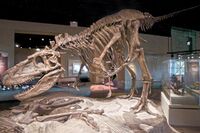
| ||
| Gorgosaurus | G. libratus | Lower-Middle, 76.6-75.1Ma ago[10] | Numerous specimens, type specimen[53] | |||
Other reptiles
Choristoderes
Choristoderes, or champsosaurs, were aquatic reptiles. Small examples looked like lizards, while larger types were superficially similar to crocodilians. Remains of the following Choristoderes have been found in the formation:[54]
- Champsosaurus (at least 3 species)
- Cteniogenys sp. cf. antiquus (possibly another genus)
Crocodylians
Remains of the following Crocodylians have been found in the formation:[55]
- Albertochampsa
- Leidyosuchus
- at least 1 unnamed taxon
Lizards
Remains of the following lizards have been found in the formation:[56]
- Helodermatids
- Labrodioctes
- Necrosaurids
- Parasaniwa
- Teiids
- Varanids
- Xenosaurids
- ?Exostinus
Plesiosaurs
Remains of the following Plesiosaurs have been found in the formation:[57]
- Fluvionectes
- indeterminate polycotylids (shorter-necked)
Pterosaurs
Remains of the following pterosaurs have been found in the formation:[58]
- Cryodrakon [59] (known from small and large specimens)
- 1 unnamed non-azhdarchid pterosaur
Turtles
Remains of the following turtles have been found in the formation:[60]
- Adocus
- "Apalone"
- Aspideretoides (3 species)
- Basilemys
- Boremys
- Judithemys
- Neurankylus
- Plesiobaena
- 2 indeterminate taxa
Mammals
Remains of the following mammals have been found in the formation:[61]
- Multituberculata
- Cimexomys sp.
- Cimolodon spp.
- Cimolomys clarki
- Meniscoessus major
- Mesodma primaeva
- unnamed multituberculates
- Metatherians
- Eutherians
- Cimolestes sp. (uncertain taxonomy)
- Gypsonictops lewisi
- Paranyctoides sternbergi
- Unknown therians: at least 1 species
Fish
Remains of the following fish have been found in the formation:[62]
- Chondrichthyans
- Cretorectolobus olsoni (a carpet shark)
- Eucrossorhinus microcuspidatus (a carpet shark)
- Ischyrhiza mira (a sclerorhynchid)[63]
- Meristodonoides montanensis (a shark)
- Myledaphus bipartitus (a ray)
- Protoplatyrhina renae (a guitarfish)
- indeterminate orectolobid
- Acipenseriformes (sturgeons)
- Holostean fish
- Lepisosteus occidentalis (the gar)
- unnamed bowfin
- at least 2 other holosteans
- Teleost fish
Invertebrates
Remains of the following invertebrates have been found in the formation:[65]
- Freshwater bivalves
- Freshwater gastropods
Flora
Plant body fossils
The following plant body fossils have been found in the formation:[66]
- various ferns
- Equisetum (Equisetaceae)
- Gymnosperms
- Platyspiroxylon (Cupressaceae)
- Podocarpoxylon (Podocarpaceae)
- Elatocladus (Taxodiaceae)
- Sequoia (Taxodiaceae)
- Sequoiaxylon (Taxodiaceae)
- Taxodioxylon (Taxodiaceae)
- Ginkgos
- Angiosperms
- Artocarpus (Moraceae)
- Cercidiphyllum (Cercidiphyllaceae)
- Dombeyopsis (Sterculiaceae)
- Menispermites (Menispermaceae)
- Pistia (Araceae)
- Platanus (Platanaceae)
- Vitis (Vitaceae)
- Trapa (Trapaceae)
Palynomorphs
Palynomorphs are organic-walled microfossils, like spores, pollen, and algae. The following palynomorphs have been found in the formation:[67]
- Unknown producers
- at least 8 species
- Fungi
- at least 35 taxa
- Chlorophyta (green algae and blue-green algae)
- at least 12 species
- Pyrrhophyta (dinoflagellates, a type of marine algae)
- unassigned cysts
- Bryophytes (mosses, liverworts, and hornworts)
- Anthocerotophyta (hornworts)
- at least 5 species
- Marchantiophyta (liverworts)
- at least 14 species
- Bryophyta (mosses)
- at least 5 species
- Anthocerotophyta (hornworts)
- Lycopodiophyta
- Lycopodiaceae (club mosses)
- at least 11 species
- Selaginellaceae (small club mosses)
- at least 6 species
- Isoetaceae (quillworts)
- at least 1 species
- Lycopodiaceae (club mosses)
- Polypodiophyta
- Osmundaceae (cinnamon ferns)
- at least 6 species
- Schizaeaceae (climbing ferns)
- at least 20 species
- Gleicheniaceae (Gleichenia and allies; coral ferns)
- at least 5 species
- Cyatheaceae (Cyathea and allies)
- at least 4 species
- Dicksoniaceae (Dicksonia and allies)
- at least 3 species
- Polypodiaceae (ferns)
- at least 4 species
- Matoniaceae
- at least 1 species
- Marsileaceae
- at least 1 species
- Osmundaceae (cinnamon ferns)
- Pinophyta (gymnosperms)
- Cycadaceae (cycads)
- at least 3 species
- Caytoniaceae
- at least 1 species
- Pinaceae (pines)
- at least 4 species
- Cupressaceae (cypresses)
- at least 3 species
- Podocarpaceae (Podocarpus and allies)
- at least 4 species
- Cheirolepidiaceae
- at least 2 species
- Ephedraceae (Mormon teas)
- at least 6 species
- Unknown gymnosperms: at least 3 species
- Cycadaceae (cycads)
- Magnoliophyta (angiosperms)
- Magnoliopsida (dicots)
- Buxaceae (boxwood)
- at least 1 species
- Gunneraceae (gunneras)
- at least 1 species
- Salicaceae (willows, cottonwood, quaking aspen)
- at least 1 species
- Droseraceae (sundews)
- at least 1 species
- Olacaceae (tallowwood)
- at least 2 species
- Loranthaceae (showy mistletoes)
- at least 1 species
- Sapindaceae (soapberry)
- at least 1 species
- Aceraceae (maples)
- at least 1 species
- Proteaceae (proteas)
- at least 9 species
- Compositae (sunflowers)
- at least 1 species
- Fagaceae (beeches, oaks, chestnuts)
- at least 2 species
- Betulaceae (birches, alders)
- at least 1 species
- Ulmaceae (elms)
- at least 1 species
- Chenopodiaceae (goosefoots)
- at least 1 species
- Buxaceae (boxwood)
- Liliopsida (monocots)
- Liliaceae (lilies)
- at least 6 species
- Cyperaceae (sedges)
- at least 1 species
- Sparganiaceae (bur-reeds)
- possibly 1 species
- Unknown angiosperms: at least 88 species
- Liliaceae (lilies)
- Magnoliopsida (dicots)
Timeline of new taxa
The following timeline displays valid taxa first discovered in the dinosaur park formation. Some species may have been referred to other genera subsequent to their initial description. <timeline> ImageSize = width:1000px height:auto barincrement:15px PlotArea = left:10px bottom:50px top:10px right:10px
Period = from:1850 till:2100 TimeAxis = orientation:horizontal ScaleMajor = unit:year increment:50 start:1850 ScaleMinor = unit:year increment:10 start:1850 TimeAxis = orientation:hor AlignBars = justify
Colors =
#legends id:CAR value:claret id:ANK value:rgb(0.4,0.3,0.196) id:HER value:teal id:HAD value:green id:OMN value:blue id:black value:black id:white value:white id:1900s value:rgb(0.94,0.25,0.24) id:2000s value:rgb(0.2,0.7,0.79) id:2000syears value:rgb(0.52,0.81,0.91) id:1900syears value:rgb(0.95,0.56,0.45) id:1700s value:rgb(0.5,0.78,0.31) id:1700syears value:rgb(0.63,0.78,0.65) id:latecretaceous value:rgb(0.74,0.82,0.37) id:1800syears value:rgb(0.95,0.98,0.11) id:paleogene value:rgb(0.99,0.6,0.32) id:paleocene value:rgb(0.99,0.65,0.37) id:eocene value:rgb(0.99,0.71,0.42) id:oligocene value:rgb(0.99,0.75,0.48) id:1800s value:rgb(0.999999,0.9,0.1) id:miocene value:rgb(0.999999,0.999999,0) id:pliocene value:rgb(0.97,0.98,0.68) id:quaternary value:rgb(0.98,0.98,0.5) id:pleistocene value:rgb(0.999999,0.95,0.68) id:holocene value:rgb(0.999,0.95,0.88)
BarData=
bar:eratop bar:space bar:periodtop bar:space bar:NAM1 bar:NAM2 bar:NAM3 bar:NAM4 bar:NAM5 bar:NAM6 bar:NAM7 bar:NAM8 bar:NAM9 bar:NAM10 bar:NAM11 bar:NAM12 bar:NAM13 bar:NAM14 bar:NAM15 bar:NAM16 bar:NAM17 bar:NAM18 bar:NAM19 bar:NAM20 bar:NAM21 bar:NAM22 bar:NAM23 bar:NAM24 bar:NAM25 bar:space bar:period bar:space bar:era
PlotData=
align:center textcolor:black fontsize:M mark:(line,black) width:25 shift:(7,-4)
bar:periodtop from: 1850 till: 1860 color:1800syears text:50s from: 1860 till: 1870 color:1800syears text:60s from: 1870 till: 1880 color:1800syears text:70s from: 1880 till: 1890 color:1800syears text:80s from: 1890 till: 1900 color:1800syears text:90s from: 1900 till: 1910 color:1900syears text:00s from: 1910 till: 1920 color:1900syears text:10s from: 1920 till: 1930 color:1900syears text:20s from: 1930 till: 1940 color:1900syears text:30s from: 1940 till: 1950 color:1900syears text:40s from: 1950 till: 1960 color:1900syears text:50s from: 1960 till: 1970 color:1900syears text:60s from: 1970 till: 1980 color:1900syears text:70s from: 1980 till: 1990 color:1900syears text:80s from: 1990 till: 2000 color:1900syears text:90s from: 2000 till: 2010 color:2000syears text:00s from: 2010 till: 2020 color:2000syears text:10s from: 2020 till: 2030 color:2000syears text:20s from: 2030 till: 2040 color:2000syears text:30s from: 2040 till: 2050 color:2000syears text:40s from: 2050 till: 2060 color:2000syears text:50s from: 2060 till: 2070 color:2000syears text:60s from: 2070 till: 2080 color:2000syears text:70s from: 2080 till: 2090 color:2000syears text:80s from: 2090 till: 2100 color:2000syears text:90s
bar:eratop from: 1850 till: 1900 color:1800s text:19th from: 1900 till: 2000 color:1900s text:20th from: 2000 till: 2100 color:2000s text:21st
PlotData=
align:left fontsize:M mark:(line,white) width:5 anchor:till align:left
color:1900s bar:NAM1 at:1902 mark:(line,black) text:Euoplocephalus color:1800s bar:NAM2 at:1902 mark:(line,black) text:"Monoclonius" belli color:1900s bar:NAM3 at:1902 mark:(line,black) text:"Ornithomimus" altus color:1900s bar:NAM4 at:1902 mark:(line,black) text:Stegoceras & S. validum color:1900s bar:NAM5 at:1902 mark:(line,black) text:"Stereocephalus" tutus color:1900s bar:NAM6 at:1904 mark:(line,black) text:Centrosaurus & C. apertus color:1800s bar:NAM7 at:1913 mark:(line,black) text:Styracosaurus & S. albertensis color:1900s bar:NAM8 at:1914 mark:(line,black) text:Chasmosaurus color:1900s bar:NAM9 at:1914 mark:(line,black) text:Corythosaurus & C. casuarius color:1900s bar:NAM10 at:1914 mark:(line,black) text:Gorgosaurus & G. libratus color:1900s bar:NAM11 at:1914 mark:(line,black) text:Gryposaurus & G. notabilis color:1800s bar:NAM12 at:1916 mark:(line,black) text:Prosaurolophus & P. maximus color:1800s bar:NAM13 at:1917 mark:(line,black) text:Struthiomimus color:1900s bar:NAM14 at:1919 mark:(line,black) text:Panoplosaurus & P. mirus color:1900s bar:NAM15 at:1922 mark:(line,black) text:Dromaeosaurus & D. albertensis color:1900s bar:NAM16 at:1922 mark:(line,black) text:Parasaurolophus & P. walkeri color:1800s bar:NAM17 at:1923 mark:(line,black) text:Lambeosaurus & L. lambei color:1900s bar:NAM18 at:1924 mark:(line,black) text:Chirostenotes & C. gracilis color:1900s bar:NAM19 at:1924 mark:(line,black) text:Dyoplosaurus & D. acutosquameus color:1900s bar:NAM20 at:1928 mark:(line,black) text:Scolosaurus & S. cutleri color:1900s bar:NAM21 at:1929 mark:(line,black) text:Anodontosaurus color:1900s bar:NAM22 at:1932 mark:(line,black) text:"Stenonychosaurus" inequalis color:1900s bar:NAM23 at:1935 mark:(line,black) text:Lambeosaurus magnicristatus color:1900s bar:NAM24 at:1940 mark:(line,black) text:Chasmosaurus russeli color:1900s bar:NAM25 at:1943 mark:(line,black) text:Hanssuesia sternbergi color:1900s bar:NAM1 at:1970 mark:(line,black) text:Daspletosaurus & D. torosus color:1900s bar:NAM2 at:1978 mark:(line,black) text:Saurornitholestes & S. langstoni color:1900s bar:NAM3 at:1979 mark:(line,black) text:Gravitholus & G. albertae color:1900s bar:NAM4 at:1990 mark:(line,black) text:Richardoestesia & R. gilmorei color:1900s bar:NAM5 at:2001 mark:(line,black) text:"Chasmosaurus" irvinensis color:1900s bar:NAM6 at:2009 mark:(line,black) text:Hesperonychus & H. elizabethae color:1800s bar:NAM7 at:2010 mark:(line,black) text:Vagaceratops color:1800s bar:NAM8 at:2012 mark:(line,black) text:Unescoceratops & U. koppelhusae color:1900s bar:NAM9 at:2013 mark:(line,black) text:Leptorhynchos & L. gaddisi color:1900s bar:NAM10 at:2016 mark:(line,black) text:Rativates & R. evadens color:1900s bar:NAM11 at:2017 mark:(line,black) text:Latenivenatrix & L. mcmasteri color:1900s bar:NAM12 at:2019 mark:(line,black) text:Cryodrakon & C. boreas
PlotData=
align:center textcolor:black fontsize:M mark:(line,black) width:25
bar:period from: 1850 till: 1860 color:1800syears text:50s from: 1860 till: 1870 color:1800syears text:60s from: 1870 till: 1880 color:1800syears text:70s from: 1880 till: 1890 color:1800syears text:80s from: 1890 till: 1900 color:1800syears text:90s from: 1900 till: 1910 color:1900syears text:00s from: 1910 till: 1920 color:1900syears text:10s from: 1920 till: 1930 color:1900syears text:20s from: 1930 till: 1940 color:1900syears text:30s from: 1940 till: 1950 color:1900syears text:40s from: 1950 till: 1960 color:1900syears text:50s from: 1960 till: 1970 color:1900syears text:60s from: 1970 till: 1980 color:1900syears text:70s from: 1980 till: 1990 color:1900syears text:80s from: 1990 till: 2000 color:1900syears text:90s from: 2000 till: 2010 color:2000syears text:00s from: 2010 till: 2020 color:2000syears text:10s from: 2020 till: 2030 color:2000syears text:20s from: 2030 till: 2040 color:2000syears text:30s from: 2040 till: 2050 color:2000syears text:40s from: 2050 till: 2060 color:2000syears text:50s from: 2060 till: 2070 color:2000syears text:60s from: 2070 till: 2080 color:2000syears text:70s from: 2080 till: 2090 color:2000syears text:80s from: 2090 till: 2100 color:2000syears text:90s
bar:era from: 1850 till: 1900 color:1800s text:19th from: 1900 till: 2000 color:1900s text:20th from: 2000 till: 2100 color:2000s text:21st
</timeline>
See also
- List of dinosaur-bearing rock formations
Footnotes
- ↑ Lexicon of Canadian Geologic Units: Dinosaur Park Formation
- ↑ Jump up to: 2.0 2.1 2.2 Eberth, D.A.; Hamblin, A.P. (1993). "Tectonic, stratigraphic, and sedimentologic significance of a regional discontinuity in the upper Judith River Group (Belly River wedge) of southern Alberta, Saskatchewan, and northern Montana". Canadian Journal of Earth Sciences 30 (1): 174–200. doi:10.1139/e93-016. Bibcode: 1993CaJES..30..174E.
- ↑ Ramezani, Jahandar; Beveridge, Tegan L.; Rogers, Raymond R.; Eberth, David A.; Roberts, Eric M. (2022-09-26). "Calibrating the zenith of dinosaur diversity in the Campanian of the Western Interior Basin by CA-ID-TIMS U–Pb geochronology". Scientific Reports 12 (1): 16026. doi:10.1038/s41598-022-19896-w. ISSN 2045-2322. PMID 36163377.
- ↑ Jump up to: 4.0 4.1 4.2 4.3 Eberth, D.A. 2005. The geology. In: Currie, P.J., and Koppelhus, E.B. (eds), Dinosaur Provincial Park: A Spectacular Ancient Ecosystem Revealed. Indiana University Press: Bloomington and Indianapolis, p.54-82. ISBN:0-253-34595-2.
- ↑ Currie, P.J., and Koppelhus, E.B. (eds), Dinosaur Provincial Park: A Spectacular Ancient Ecosystem Revealed. Indiana University Press: Bloomington and Indianapolis, p. 277-291. ISBN:0-253-34595-2.
- ↑ Mallon, Jordan C.; S, Jason (2012). "Megaherbivorous dinosaur turnover in the Dinosaur Park Formation (upper Campanian) of Alberta, Canada". Palaeogeography, Palaeoclimatology, Palaeoecology 350-352: 124–138. doi:10.1016/j.palaeo.2012.06.024. Bibcode: 2012PPP...350..124M. https://www.smithsonianmag.com/science-nature/dinosaur-turnover-12902697/.
- ↑ Ryan and Evans (2005).
- ↑ Jump up to: 8.0 8.1 Evans D.C.; Bavington R.; Campione N.E. (2009). "An unusual hadrosaurid braincase from the Dinosaur Park Formation and the biostratigraphy of Parasaurolophus (Ornithischia: Lambeosaurinae) from southern Alberta". Canadian Journal of Earth Sciences 46 (11): 791–800. doi:10.1139/E09-050. Bibcode: 2009CaJES..46..791E. http://www.freepatentsonline.com/article/Canadian-Journal-Earth-Sciences/215925510.html.[yes|permanent dead link|dead link}}]
- ↑ Fowler, Denver Warwick (2017-11-22). "Revised geochronology, correlation, and dinosaur stratigraphic ranges of the Santonian-Maastrichtian (Late Cretaceous) formations of the Western Interior of North America" (in en). PLOS ONE 12 (11): e0188426. doi:10.1371/journal.pone.0188426. ISSN 1932-6203. PMID 29166406.
- ↑ Jump up to: 10.00 10.01 10.02 10.03 10.04 10.05 10.06 10.07 10.08 10.09 10.10 10.11 10.12 10.13 10.14 10.15 Arbour, V. M.; Burns, M. E.; Sissons, R. L. (2009). "A redescription of the ankylosaurid dinosaur Dyoplosaurus acutosquameus Parks, 1924 (Ornithischia: Ankylosauria) and a revision of the genus". Journal of Vertebrate Paleontology 29 (4): 1117–1135. doi:10.1671/039.029.0405.
- ↑ Jump up to: 11.0 11.1 11.2 Penkalski, P. (2013). "A new ankylosaurid from the late Cretaceous Two Medicine Formation of Montana, USA". Acta Palaeontologica Polonica. doi:10.4202/app.2012.0125.
- ↑ Mallon, J. C., Evans, D. C., Ryan, M. J., & Anderson, J. S. (2012). Megaherbivorous dinosaur turnover in the Dinosaur Park Formation (upper Campanian) of Alberta, Canada. Palaeogeography, Palaeoclimatology, Palaeoecology.
- ↑ Gardner, J.D. 2005. Lissamphibians. In: Currie, P.J., and Koppelhus, E.B. (eds), Dinosaur Provincial Park: A Spectacular Ancient Ecosystem Revealed. Indiana University Press: Bloomington and Indianapolis, p. 186-201. ISBN:0-253-34595-2.
- ↑ "Fossilworks: Gateway to the Paleobiology Database". http://www.fossilworks.org/cgi-bin/bridge.pl?a=collectionSearch&collection_no=22698.
- ↑ "Fossilworks: Gateway to the Paleobiology Database". http://www.fossilworks.org/cgi-bin/bridge.pl?a=collectionSearch&collection_no=14463.
- ↑ Currie, P.J. 2005. Theropods, including birds. In: Currie, P.J., and Koppelhus, E.B. (eds), Dinosaur Provincial Park: A Spectacular Ancient Ecosystem Revealed. Indiana University Press: Bloomington and Indianapolis, p. 367-397. ISBN:0-253-34595-2.
- ↑ Ryan, M.J., and Evans, D.C. 2005. Ornithischian dinosaurs. In: Currie, P.J., and Koppelhus, E.B. (eds), Dinosaur Provincial Park: A Spectacular Ancient Ecosystem Revealed. Indiana University Press: Bloomington and Indianapolis, p. 312-348. ISBN:0-253-34595-2.
- ↑ Jump up to: 18.0 18.1 18.2 18.3 18.4 18.5 18.6 Penkalski, Paul (2018). "Revised systematics of the armoured dinosaur Euoplocephalus and its allies". Neues Jahrbuch für Geologie und Paläontologie - Abhandlungen 287 (3): 261–306. doi:10.1127/njgpa/2018/0717.
- ↑ "Table 17.1," in Weishampel, et al. (2004). Page 365.
- ↑ Penkalski, Paul (2013). "A new ankylosaurid from the late Cretaceous Two Medicine Formation of Montana, USA". Acta Palaeontologica Polonica. doi:10.4202/app.2012.0125.
- ↑ Ryan, Michael; Eberth, David; Brinkman, Donald; Currie, Philip; Tanke, Darren (January 2010). New Perspectives on Horned Dinosaurs. pp. 141–155. https://www.researchgate.net/publication/284893179. Retrieved 16 January 2022.
- ↑ Jump up to: 22.0 22.1 22.2 "Table 23.1," in Weishampel, et al. (2004). Page 495.
- ↑ RYAN, M. J.; RUSSELL, A. P.; EBERTH, D. A.; CURRIE, P. J. (2001-10-01). "The Taphonomy of a Centrosaurus (Ornithischia: Certopsidae) Bone Bed from the Dinosaur Park Formation (Upper Campanian), Alberta, Canada, with Comments on Cranial Ontogeny". PALAIOS 16 (5): 482–506. doi:10.1669/0883-1351(2001)016<0482:ttoaco>2.0.co;2. ISSN 0883-1351. Bibcode: 2001Palai..16..482R.
- ↑ Jump up to: 24.0 24.1 "Table 23.1," in Weishampel, et al. (2004). Page 496.
- ↑ Jump up to: 25.0 25.1 25.2 Ryan, Michael J.; Evans, David C.; Currie, Phillip J.; Loewen, Mark A. (2014). "A New chasmosaurine from northern Laramidia expands frill disparity in ceratopsid dinosaurs". Naturwissenschaften 101 (6): 505–512. doi:10.1007/s00114-014-1183-1. PMID 24859020. Bibcode: 2014NW....101..505R.
- ↑ Jump up to: 26.0 26.1 26.2 26.3 Nicholas R. Longrich (2014). "The horned dinosaurs Pentaceratops and Kosmoceratops from the upper Campanian of Alberta and implications for dinosaur biogeography". Cretaceous Research 51: 292–308. doi:10.1016/j.cretres.2014.06.011.
- ↑ Jordan C. Mallon; Christopher J. Ott; Peter L. Larson; Edward M. Iuliano; David C. Evans (2016). "Spiclypeus shipporum gen. et sp. nov., a Boldly Audacious New Chasmosaurine Ceratopsid (Dinosauria: Ornithischia) from the Judith River Formation (Upper Cretaceous: Campanian) of Montana, USA". PLOS ONE 11 (5): e0154218. doi:10.1371/journal.pone.0154218. PMID 27191389. Bibcode: 2016PLoSO..1154218M.
- ↑ Jump up to: 28.0 28.1 28.2 28.3 28.4 Farke, Andrew A.; Michael J. Ryan; Paul M. Barrett; Darren H. Tanke; Dennis R. Braman; Mark A. Loewen; Mark R. Graham (2011). "A new centrosaurine from the Late Cretaceous of Alberta, Canada, and the evolution of parietal ornamentation in horned dinosaurs". Acta Palaeontologica Polonica 56 (4): 691–702. doi:10.4202/app.2010.0121. http://www.app.pan.pl/archive/published/app56/app20100121.pdf.
- ↑ Michael J. Ryan; David C. Evans; Philip J. Currie; Caleb M. Brown; Don Brinkman (2012). "New leptoceratopsids from the Upper Cretaceous of Alberta, Canada". Cretaceous Research 35: 69–80. doi:10.1016/j.cretres.2011.11.018.
- ↑ Scott D. Sampson; Mark A. Loewen; Andrew A. Farke; Eric M. Roberts; Catherine A. Forster; Joshua A. Smith; Alan L. Titus (2010). "New Horned Dinosaurs from Utah Provide Evidence for Intracontinental Dinosaur Endemism". PLOS ONE 5 (9): e12292. doi:10.1371/journal.pone.0012292. PMID 20877459. Bibcode: 2010PLoSO...512292S.
- ↑ Jump up to: 31.0 31.1 "Abstract," Tanke and Brett-Surman (2001). Page 206.
- ↑ "Conclusions," Tanke and Brett-Surman (2001). Page 212.
- ↑ Jump up to: 33.0 33.1 "Eggshell," Tanke and Brett-Surman (2001). Page 209.
- ↑ "Introduction," Tanke and Brett-Surman (2001). Page 208.
- ↑ "Discussion," Tanke and Brett-Surman (2001). Page 212.
- ↑ "Table 20.1," in Weishampel, et al. (2004). Page 441.
- ↑ Jump up to: 37.0 37.1 "Table 20.1," in Weishampel, et al. (2004). Page 440.
- ↑ Jump up to: 38.0 38.1 38.2 "Table 20.1," in Weishampel, et al. (2004). Page 442.
- ↑ Jump up to: 39.0 39.1 "Table 21.1," in Weishampel, et al. (2004). Page 465.
- ↑ Jump up to: 40.0 40.1 Dyer, Aaron D.; Powers, Mark J.; Currie, Philip J. (2023). "Problematic putative pachycephalosaurids: Synchrotron µCT imaging shines new light on the anatomy and taxonomic validity of Gravitholus albertae from the Belly River Group (Campanian) of Alberta, Canada" (in en). Vertebrate Anatomy Morphology Palaeontology 10 (1): 65-110. doi:10.18435/vamp29388. ISSN 2292-1389. https://journals.library.ualberta.ca/vamp/index.php/VAMP/article/view/29388.
- ↑ Jump up to: 41.0 41.1 41.2 Woodruff, D. Cary; Schott, Ryan K.; Evans, David C. (2023-11-15). "Two new species of small‐bodied pachycephalosaurine (Dinosauria, Marginocephalia) from the uppermost Cretaceous of North America suggest hidden diversity in well‐sampled formations" (in en). Papers in Palaeontology 9 (6): e1535. doi:10.1002/spp2.1535. ISSN 2056-2799.
- ↑ Jump up to: 42.0 42.1 "Introduction," Jacobsen (2001). Page 59.
- ↑ "Discussion," Jacobsen (2001). Page 61.
- ↑ Longrich, N. R. (2014). "The horned dinosaurs Pentaceratops and Kosmoceratops from the upper Campanian of Alberta and implications for dinosaur biogeography". Cretaceous Research 51: 292. doi:10.1016/j.cretres.2014.06.011.
- ↑ Longrich, N (2008). "A new, large ornithomimid from the Cretaceous Dinosaur Park Formation of Alberta, Canada: Implications for the study of dissociated dinosaur remains". Palaeontology 51 (4): 983–997. doi:10.1111/j.1475-4983.2008.00791.x.
- ↑ Jump up to: 46.0 46.1 McFeeters, B.; Ryan, M. J.; Schröder-Adams, C.; Currie, P. J. (2017). "First North American occurrences of Qiupalong (Theropoda: Ornithomimidae) and the palaeobiogeography of derived ornithomimids". FACETS 2 (1): 355–373. doi:10.1139/facets-2016-0074.
- ↑ McFeeters, B. (2016). "A new ornithomimid theropod from the Dinosaur Park Formation of Alberta, Canada". Journal of Vertebrate Paleontology 36 (6): e1221415. doi:10.1080/02724634.2016.1221415.
- ↑ Longrich, N. R.; Barnes, K.; Clark, S.; Millar, L. (2013). "Caenagnathidae from the Upper Campanian Aguja Formation of West Texas, and a Revision of the Caenagnathinae". Bulletin of the Peabody Museum of Natural History 54: 23–49. doi:10.3374/014.054.0102.
- ↑ Jump up to: 49.0 49.1 49.2 Funston, Gregory (2020-07-27). "Caenagnathids of the Dinosaur Park Formation (Campanian) of Alberta, Canada: anatomy, osteohistology, taxonomy, and evolution". Vertebrate Anatomy Morphology Palaeontology 8: 105–153. doi:10.18435/vamp29362. ISSN 2292-1389.
- ↑ Jump up to: 50.0 50.1 Sankey, Julia T.; Brinkman, Donald B.; Guenther, Merrilee; Currie, Philip J. (2002). "Small Theropod and Bird Teeth from the Late Cretaceous (Late Campanian) Judith River Group, Alberta". Journal of Paleontology 76 (4): 751–763. doi:10.1666/0022-3360(2002)076<0751:STABTF>2.0.CO;2. ISSN 0022-3360.
- ↑ Currie, Philip J.; Larson, Derek W. (2013-01-23). "Multivariate Analyses of Small Theropod Dinosaur Teeth and Implications for Paleoecological Turnover through Time" (in en). PLOS ONE 8 (1): e54329. doi:10.1371/journal.pone.0054329. ISSN 1932-6203. PMID 23372708. Bibcode: 2013PLoSO...854329L.
- ↑ "Abstract," Jacobsen (2001). Page 58.
- ↑ Cite error: Invalid
<ref>tag; no text was provided for refs namedcurrie2003a - ↑ K.Gao and Brinkman, D.B. 2005. Choristoderes from the Park and its vicinity. In: Currie, P.J., and Koppelhus, E.B. (eds), Dinosaur Provincial Park: A Spectacular Ancient Ecosystem Revealed. Indiana University Press: Bloomington and Indianapolis, p. 221-234. ISBN:0-253-34595-2.
- ↑ Xiao-Chun Wu. 2005. Crocodylians. In: Currie, P.J., and Koppelhus, E.B. (eds), Dinosaur Provincial Park: A Spectacular Ancient Ecosystem Revealed. Indiana University Press: Bloomington and Indianapolis, p. 277-291. ISBN:0-253-34595-2.
- ↑ Caldwell, M.W. The squamates: origins, phylogeny, and paleoecology. In: Currie, P.J., and Koppelhus, E.B. (eds). 2005. Dinosaur Provincial Park: A Spectacular Ancient Ecosystem Revealed. Indiana University Press: Bloomington and Indianapolis, p. 235-248. ISBN:0-253-34595-2.
- ↑ Sato, T., Eberth, D.A., Nicholls, E.L., and Manabe, M. 2005. Plesiosaurian remains from non-marine to paralic sediments. In: Currie, P.J., and Koppelhus, E.B. (eds), Dinosaur Provincial Park: A Spectacular Ancient Ecosystem Revealed. Indiana University Press: Bloomington and Indianapolis, p. 249-276. ISBN:0-253-34595-2.
- ↑ Godfrey, S.J., and Currie, P.J. 2005. Pterosaurs. In: Currie, P.J., and Koppelhus, E.B. (eds), Dinosaur Provincial Park: A Spectacular Ancient Ecosystem Revealed. Indiana University Press: Bloomington and Indianapolis, p. 292-311. ISBN:0-253-34595-2.
- ↑ David W. E. Hone; Michael B. Habib; François Therrien (2019). "Cryodrakon boreas gen. et sp. nov. a Late Cretaceous Canadian azhdarchid pterosaur". Journal of Vertebrate Paleontology 39 (3): e1649681. doi:10.1080/02724634.2019.1649681. https://qmro.qmul.ac.uk/xmlui/handle/123456789/60704.
- ↑ Brinkman, D.B. 2005. Turtles: diversity, paleoecology, and distribution. In: Currie, P.J., and Koppelhus, E.B. (eds), Dinosaur Provincial Park: A Spectacular Ancient Ecosystem Revealed. Indiana University Press: Bloomington and Indianapolis, p. 202-220. ISBN:0-253-34595-2.
- ↑ Fox, R.C. 2005. Late Cretaceous mammals. In: Currie, P.J., and Koppelhus, E.B. (eds), Dinosaur Provincial Park: A Spectacular Ancient Ecosystem Revealed. Indiana University Press: Bloomington and Indianapolis, p. 417-435. ISBN:0-253-34595-2.
- ↑ Neuman, A.G., and Brinkman, D.B. 2005. Fishes of the fluvial beds. In: Currie, P.J., and Koppelhus, E.B. (eds), Dinosaur Provincial Park: A Spectacular Ancient Ecosystem Revealed. Indiana University Press: Bloomington and Indianapolis, p. 167-185. ISBN:0-253-34595-2.
- ↑ "Fossilworks: Gateway to the Paleobiology Database". http://www.fossilworks.org/cgi-bin/bridge.pl?a=collectionSearch&collection_no=22640.
- ↑ Hiroki Sato; Alison M. Murray; Oksana Vernygora; Philip J. Currie (2018). "A rare, articulated sturgeon (Chondrostei: Acipenseriformes) from the Upper Cretaceous of Dinosaur Provincial Park, Alberta, Canada". Journal of Vertebrate Paleontology 38 (4): (1)-(15). doi:10.1080/02724634.2018.1488137.
- ↑ Johnston, P.A., and Hendy, A.J.W. 2005. Paleoecology of mollusks from the Upper Cretaceous Belly River Group. In: Currie, P.J., and Koppelhus, E.B. (eds), Dinosaur Provincial Park: A Spectacular Ancient Ecosystem Revealed. Indiana University Press: Bloomington and Indianapolis, p. 139-166. ISBN:0-253-34595-2.
- ↑ Koppelhus, E.B. 2005. Paleobotany. In: Currie, P.J., and Koppelhus, E.B. (eds), Dinosaur Provincial Park: A Spectacular Ancient Ecosystem Revealed. Indiana University Press: Bloomington and Indianapolis, p. 131-138. ISBN:0-253-34595-2.
- ↑ Braman, D.R., and Koppelhus, E.B. 2005. Campanian palynomorphs. In: Currie, P.J., and Koppelhus, E.B. (eds), Dinosaur Provincial Park: A Spectacular Ancient Ecosystem Revealed. Indiana University Press: Bloomington and Indianapolis, p. 101-130. ISBN:0-253-34595-2.
References
- Arbour, V. M.; Burns, M. E.; Sissons, R. L. (2009). "A redescription of the ankylosaurid dinosaur Dyoplosaurus acutosquameus Parks, 1924 (Ornithischia: Ankylosauria) and a revision of the genus". Journal of Vertebrate Paleontology 29 (4): 1117–1135. doi:10.1671/039.029.0405.
- Braman, D.R., and Koppelhus, E.B. 2005. Campanian palynomorphs. In: Currie, P.J., and Koppelhus, E.B. (eds), Dinosaur Provincial Park: A Spectacular Ancient Ecosystem Revealed. Indiana University Press: Bloomington and Indianapolis, 101–130.
- Brinkman, D.B. 2005. Turtles: diversity, paleoecology, and distribution. In: Currie, P.J., and Koppelhus, E.B. (eds), Dinosaur Provincial Park: A Spectacular Ancient Ecosystem Revealed. Indiana University Press: Bloomington and Indianapolis, 202–220.
- Caldwell, M.W. The squamates: origins, phylogeny, and paleoecology. In: Currie, P.J., and Koppelhus, E.B. (eds). 2005. Dinosaur Provincial Park: A Spectacular Ancient Ecosystem Revealed. Indiana University Press: Bloomington and Indianapolis, 235–248.
- Currie, P.J. 2005. Theropods, including birds. In: Currie, P.J., and Koppelhus, E.B. (eds), Dinosaur Provincial Park: A Spectacular Ancient Ecosystem Revealed. Indiana University Press: Bloomington and Indianapolis, 367–397.
- Currie, P.J., and Koppelhus, E.B. (eds). 2005. Dinosaur Provincial Park: A Spectacular Ancient Ecosystem Revealed. Indiana University Press: Bloomington and Indianapolis, 648 p.
- Eberth, D.A. 2005. The geology. In: Currie, P.J., and Koppelhus, E.B. (eds), Dinosaur Provincial Park: A Spectacular Ancient Ecosystem Revealed. Indiana University Press: Bloomington and Indianapolis, 54–82.
- Fox, R.C. 2005. Late Cretaceous mammals. In: Currie, P.J., and Koppelhus, E.B. (eds), Dinosaur Provincial Park: A Spectacular Ancient Ecosystem Revealed. Indiana University Press: Bloomington and Indianapolis, 417–435.
- K. Gao and Brinkman, D.B. 2005. Choristoderes from the Park and its vicinity. In: Currie, P.J., and Koppelhus, E.B. (eds), Dinosaur Provincial Park: A Spectacular Ancient Ecosystem Revealed. Indiana University Press: Bloomington and Indianapolis, 221–234.
- Gardner, J.D. 2005. Lissamphibians. In: Currie, P.J., and Koppelhus, E.B. (eds), Dinosaur Provincial Park: A Spectacular Ancient Ecosystem Revealed. Indiana University Press: Bloomington and Indianapolis, 186–201.
- Godfrey, S.J., and Currie, P.J. 2005. Pterosaurs. In: Currie, P.J., and Koppelhus, E.B. (eds), Dinosaur Provincial Park: A Spectacular Ancient Ecosystem Revealed. Indiana University Press: Bloomington and Indianapolis, 292–311.
- Johnston, P.A., and Hendy, A.J.W. 2005. Paleoecology of mollusks from the Upper Cretaceous Belly River Group. In: Currie, P.J., and Koppelhus, E.B. (eds), Dinosaur Provincial Park: A Spectacular Ancient Ecosystem Revealed. Indiana University Press: Bloomington and Indianapolis, 139–166.
- Koppelhus, E.B. 2005. Paleobotany. In: Currie, P.J., and Koppelhus, E.B. (eds), Dinosaur Provincial Park: A Spectacular Ancient Ecosystem Revealed. Indiana University Press: Bloomington and Indianapolis, 131–138.
- Lexicon of Canadian Geologic Units. "Dinosaur Park Formation". http://cgkn1.cgkn.net/weblex/weblex_litho_detail_e.pl?00053:004018.
- Neuman, A.G., and Brinkman, D.B. 2005. Fishes of the fluvial beds. In: Currie, P.J., and Koppelhus, E.B. (eds), Dinosaur Provincial Park: A Spectacular Ancient Ecosystem Revealed. Indiana University Press: Bloomington and Indianapolis, 167–185.
- Ryan, M.J., and Evans, D.C. 2005. Ornithischian dinosaurs. In: Currie, P.J., and Koppelhus, E.B. (eds), Dinosaur Provincial Park: A Spectacular Ancient Ecosystem Revealed. Indiana University Press: Bloomington and Indianapolis, 312–348.
- Sato, T., Eberth, D.A., Nicholls, E.L., and Manabe, M. 2005. Plesiosaurian remains from non-marine to paralic sediments. In: Currie, P.J., and Koppelhus, E.B. (eds), Dinosaur Provincial Park: A Spectacular Ancient Ecosystem Revealed. Indiana University Press: Bloomington and Indianapolis, 249–276.
- Tanke, D.H. and Brett-Surman, M.K. 2001. Evidence of Hatchling and Nestling-Size Hadrosaurs (Reptilia:Ornithischia) from Dinosaur Provincial Park (Dinosaur Park Formation: Campanian), Alberta, Canada. pp. 206–218. In: Mesozoic Vertebrate Life—New Research Inspired by the Paleontology of Philip J. Currie. Edited by D.H. Tanke and K. Carpenter. Indiana University Press: Bloomington. xviii + 577 pp.
- Xiao-Chun Wu. 2005. Crocodylians. In: Currie, P.J., and Koppelhus, E.B. (eds), Dinosaur Provincial Park: A Spectacular Ancient Ecosystem Revealed. Indiana University Press: Bloomington and Indianapolis, 277-291
 |

